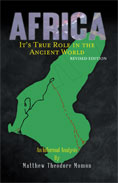
 |
In any pedagogical program, educators are trained to promote inquiry, to encourage their students to probe deeper, and to ask who, what, where, when, and why. Momon’s work exhibits the same instructional tendencies as it challenges preconceived notions using a background in STEM, specifically math and science, alongside extensive research. At its core, though, this is the work of an inquisitive mind, an intensely curious individual who is unyielding in his intent to help both himself and his readers navigate through the labyrinth of human history to ultimately uncover hidden truths.
While there are numerous conspiracy theorists who have transformed their ideas into literature, Momon’s work distances itself by using concrete and relatable examples, both historical and contemporary, with which his readers can form a connection. Undoubtedly, one of the intriguing aspects of the entire compilation is the author’s fearless voice; he adheres loyally to his truth and his beliefs that the legacy of Africa has been severely tampered with and rewritten by the Europeans. In the process, he examines an infinite range of topics, spanning everything from religion and academic systems to the countless contributions and innovative nature of Black America. As the author progresses from example to example, the discourse becomes less of an “agree or disagree” and more of a thought-provoking and unconventional yet powerful way to interpret history.
According to the author, there is a deliberate and blatant attempt at suppressing the African American legacy and its contributions to society. For instance, he notes that there are over two thousand patents earned by African Americans between 1865 and 1940, yet names like Elihag McCoy, John Hanson, and Albert Robinson are buried deep in the history books and, often, altogether nonexistent. It is difficult to argue against the author’s notion that the portrayal of African culture is downright inferior, the “personification of a criminal.” While citing the histories of Egypt and using examples of Isis/Osiris and the pyramids of Giza, he not only creates parallels and discerns similarities between African and Greek names but also pleads with African Americans to awaken and embrace their true identity as an ancient, highly intelligent culture with unlimited capacities.
From the Roman culture being born out of disdain for Africans and Cleopatra’s forced suicide to references to Socrates, Aristotle, and Emperor Constantine, Momon’s work transforms into a chronological account of monumental inflection points in all facets of human history. Astoundingly, he denotes that it took the Europeans 1,918 years to gain control of Africa for themselves. He doesn’t stop there, either, demonstrating how the majority of athletes in the major sports (e.g., NBA, NFL) are black, citing how former players like Shaq tower above the rest of society and are revered like gods in their own right.
Tying his entire argument through science and math, with references to Mendel and Punnett squares, he appeals to modern society by using popular movie offerings like the Matrix series and demonstrating how the city of Detroit is the ideal African city, a spitting adaptation of downtown Alexandria. Momon states that math and science are the languages of the universe, the bedrock of civilization. African mastery of math and science makes it unquestionable just how potent of a culture it was, is, and continues to be. Ultimately, Momon’s work is comprehensive and insightful, an investigative survey of historical proportions with the potential to reshape how one views the events of the past as they are applied to the perceptions of the present and future.